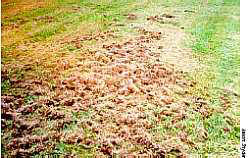|
Frost, pumpkins and holes in the yard
By John
Fulton
 Send a link to a friend
Send a link to a friend
[OCT. 9, 2006]
With the prediction of temperatures in the
lower 30s or below, it's time to assess annual plants you want to
try to save for a little while. Annuals are going to get zapped;
it's just a question of when. Temperatures in the mid-20s are going
to get about everything, even if covered.
|
|
The usual tactic to provide protection consists of covering
susceptible plants with tarps, old blankets, sheets, etc. This
method usually protects portions of the plants close to the
ground, while cold temperatures will freeze through the material
and kill the tops of the plants. Another practice is to use
cardboard boxes, and these provide a little better protection.
The next question is how many refrigerator boxes it takes to
protect 12 tomato plants. And then there is the wind. Wind ahead
of a cold front makes it difficult to keep any type of cover
over the plants. Select what you want to protect. You may not
be able to cover all 12 tomatoes, so pick the ones you want to
save. Do the best job of covering possible. Pick some of the
fruits that are on exposed plants. Tomatoes will go ahead and
ripen; of course, they won't be of quite the same quality as
vine-ripened. And finally, we knew the end would come. It was
only a matter of time, and some years the time comes earlier.
Pumpkin time
For all those who decorate for Halloween and Thanksgiving,
it's time to select that orange globe to set out by a corn shock
or to carve into a jack-o'-lantern. With some of the heavy
frosts we've had, it's critical to check pumpkins over carefully
before purchasing. Following are some of the cardinal rules for
selecting and keeping pumpkins:
-
Choose a
pumpkin with a stem, but never carry it by the stem.
Pumpkins without a stem will not last long.
-
Select a
pumpkin with a flat bottom, so it will stand upright
-
Avoid pumpkins
with holes, cuts or soft spots. These areas will rot.
-
Light-colored
pumpkins are easier to carve because the skin is not as hard
as darker orange-colored ones, but they will not keep as
well.
-
Wash the
pumpkin with warm water and let it dry before carving. Use
of a small amount of dishwashing soap in the warm water may
help extend the life of the pumpkin.
-
To make the
pumpkin last longer, keep it in a cool place until ready to
carve. After carving, coat the cuts with petroleum jelly.
-
Carving should
wait until three days ahead of Halloween. After cutting, the
pumpkin will deteriorate rapidly.
-
The use of a
candle in the pumpkin will also make it deteriorate rapidly.
[to top of second column] |
 Holes in the yard
I promised myself no insects in this week's column. Many people
think holes in the yard means insects. We're on the late side for
things like the cicada killer wasp, but we can see where skunks or
raccoons have been digging in certain areas. See the accompanying
photo from the Ohio Department of Natural Resources. What are they
after? Well, they're after food. And to these critters, food means
grubs. Oh well, I came close to no insects this week.

Grubs have been active since midsummer. Normal treatment time is
around the Logan County Fair. The longer we wait, the larger the
grubs get. In particular, moles and skunks can smell the grubs and
go after them for a meal. It is good to get rid of the grubs, but
sometimes the cure is worse than the original problem. It is still
possible to treat for grubs, but don't expect the same percentage of
control you would have had two months ago.
The best way to stop moles and skunks is to get rid of the food
source. Many of the trapping methods for moles don't work very well.
And skunks… Well, you can just figure that one out for yourself.
Live traps are an option, but being successful creates another
problem. Moles like grubs and worms to eat, so poison peanuts
probably aren't going to be very effective. There are some new soft
baits that are more effective but much more costly.
[John
Fulton, unit leader,
University of Illinois Extension,
Logan County Unit]
 |